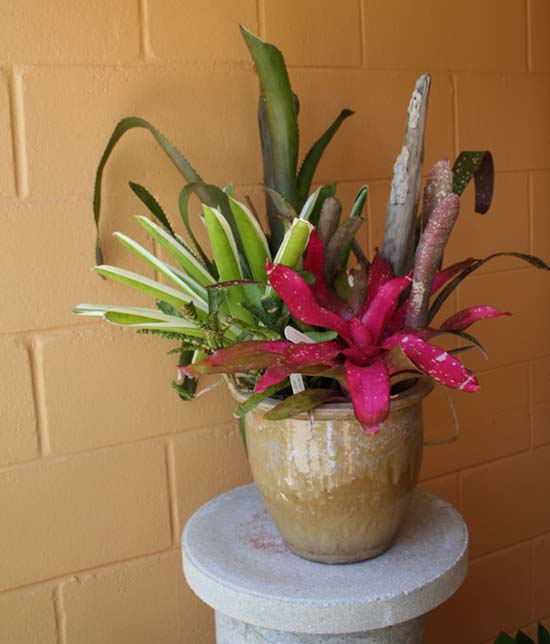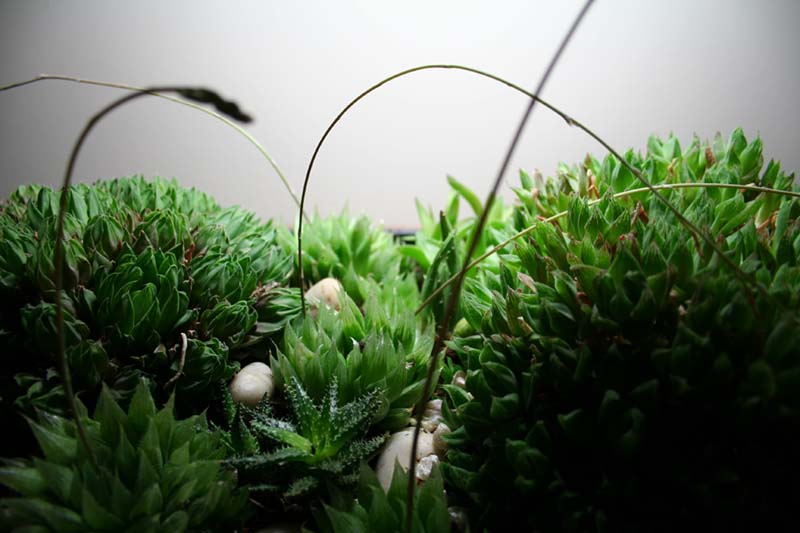A home packed with healthy houseplants says a lot about the person who lives there. They’re nurturing, knowledgeable, responsible.
Or maybe they just know how to pick plants that can thrive without a lot of attention.
If you’re looking for low-key houseplants, this list is for you. These 10 varieties will fill your home with green - even if your thumb isn’t.
Aspidistra
It withstood Victorian England's coal soot, cold drafts and depressing lack of light, so surely “cast iron plant” can survive in your home.

Bromeliad flowers come in a range of colors to create visual interest.
It's cold-tolerant enough to grow in the Lower South, handles the deepest shade of your home - well, almost - and survives for long periods without water. It has strappy leaves of glossy deep green, but if that sounds boring, keep an eye out for unusual variegated varieties.
Bromeliads
If you never know when to water your houseplants, bromeliads are for you. Their tightly overlapping leaves form a cup, and all you have to do is keep it filled with water. Just let a little dribble over the sides of the plant to wet the potting mix.
Unlike many of the bloomless houseplants on this list, bromeliads have enough different flower types and colors to make your head spin. The leathery leaves themselves are often just as interesting, with all sorts of colors and patterns. Most do best in bright, indirect light.
Fiddle leaf fig
Rubber ficus is way overused, and weeping ficus (also overused) sheds leaves at the drop of a hat.
Fiddle leaf fig, on the other hand, is just as tough as the rest, but has large, friendly bright green leaves in the shape of a guitar or fiddle.
They can grow quite tall, but respond well to pruning. I often go over a month without watering mine because it takes that long to start looking thirsty.
Haworthia

Haworthia is a great option for gardeners who like lots of variety in one plant.
Succulents are notoriously needy when it comes to sunlight, but this is not the case with Haworthia. These South-African succulents are a collector's dream, with multitudes of species and unusual forms, ranging from rosettes of narrow leaves with black-and-white zebra stripes to clear and fleshy leaves that look like something between translucent gems and bubbles.
Parlor palm
If it's a tropical look you're after, you could do no better than the parlor palm (Chamaedorea elegans) and its glossy, feathery fronds. The ones you'll find for sale are almost always seedlings, but given enough time and some bright, indirect light, they'll form narrow green trunks, insignificant flowers and bright red berries.
Although parlor palm is quite resilient, water deeply since they're sensitive to hard water buildup.
Pothos
You could call it a classic, or you could call it washed up. You could call their distinctive patterning of gold, green and cream something fancy like “marbling,” or you could call it radioactive throw-up. Both descriptions apply.
Killing golden pothos (Epipremnum aureum) takes a considerable amount of overwatering or neglect. Trim it when it gets too lanky, and place the stems in a vase. When roots form, plant them in fresh potting mix for brand new houseplants.
Rhipsalis
Picture a cactus: Prickly, lives in a desert - pretty predictable. But when you see a mistletoe cactus (Rhipsalis species), with its deep green and spineless stems hanging like angel's hair from the pot, you'd never ever think it was a cactus.
Not only does it look decidedly un-cactus-like, Rhipsalis grows on tree limbs in the rainforest. They can take more shade and survive on neglect, but still look a lot better with a little TLC.
Snake plant

Snake plant and ZZ plant coexist happily in a cheerful container.
Plain ol' variegated snake plant (Sansevieria trifasciata) has been a staple of doctors' offices since the middle of the last century, but now there are all sorts of variegated forms and interesting shapes to complement any modern decor.
Some are short and squat, and would be at home in the smallest of cubicles. Others are tall and pointy. All are very tolerant of drought and low light.
Yucca
Most yuccas are too spiky to be grown safely in close quarters with people, but soft-leaved Yucca (Yucca elephantipes) only looks spiky. It is, however, tough as nails. It's so hardcore that it survived the ownership of my sister, who watered it maybe once or twice over the course of a year. Yucca is a desert plant and prefers direct to bright indirect sunlight, though it can survive in less.
ZZ Plant
With a name like “ZZ Plant,” you know it just has to be cool. Like a cross between a succulent, a fern and a philodendron, ZZ plant (Zamioculcas) sports fleshy, shiny green fronds that like something out of the Cretaceous period.
Though a newcomer to the houseplant scene, it will last a very long time in the hands of a black-thumbed indoor gardener. I should know, since I keep forgetting I even have it.
Related:
- Troubleshooting Houseplant Woes
- Secrets to a Thriving Indoor Herb Garden
- Air Plants and Succulents: A Perfect Pair
from Zillow Blog - Real Estate Market Stats, Celebrity Real Estate, and Zillow News http://www.zillow.com/blog/10-houseplants-you-cant-kill-185910/
via Reveeo
No comments:
Post a Comment